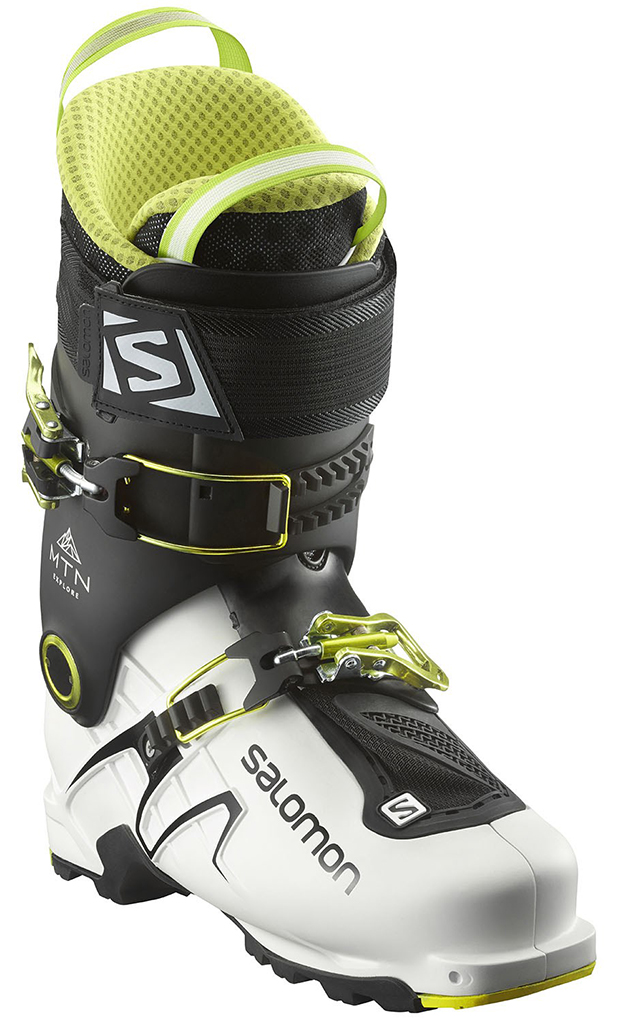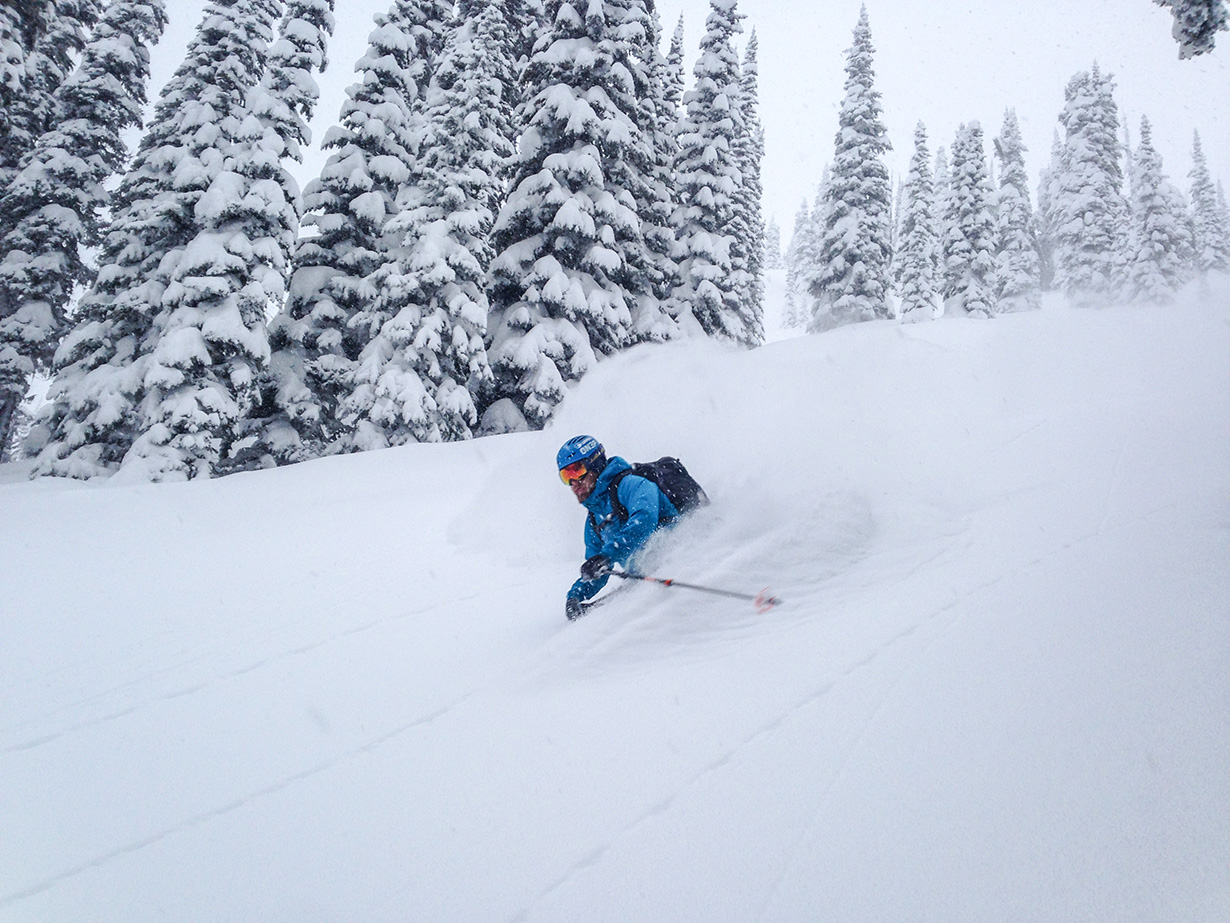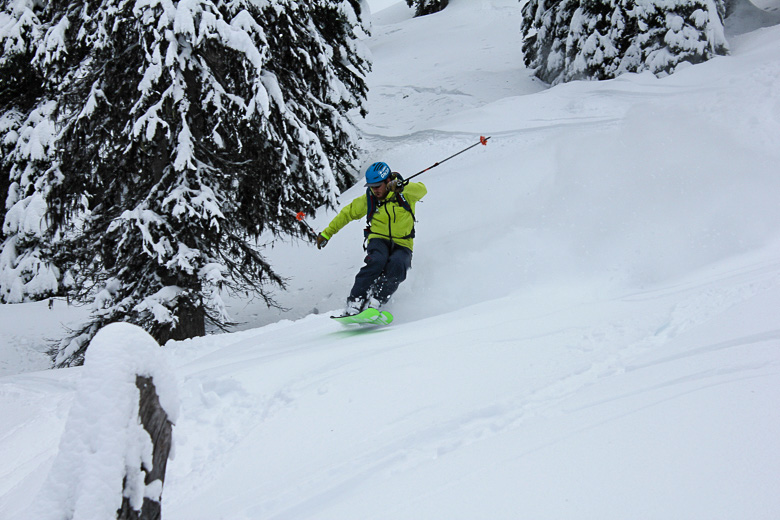
3rd Look: Salomon MTN Explore
Available Sizes: 24.5 – 29.5
Size Tested: 26.5
Stated BSL (26.5): 301 mm
Stated Flex: 110
Stated Last: 98 mm
Stated Range of Motion: 63°
Binding Compatibility:
- MNC (Multi-Norm Compatible) bindings
- Tech (“pin”) bindings
Blister’s Measured Weight:
- shells, no liners: 1126 & 1135 grams
- stock liners + laces, no footbeds: 281 & 281 g
- shells + stock liners: 1407 & 1416 g
MSRP: $700
Test Locations: Whitefish Mountain Resort and backcountry, Northwest Montana Backcountry; Revelstoke Mountain Resort, CA
Ski / Bindings:184 cm ON3P Steeple 108 with Dynafit Radical FT 1.0 and Fritschi Diamir Vipec 12; 184 cm ON3P Steeple 116 with Dynafit Radical 2.0
Days Tested: ~20
Intro
Yep, we’re taking a 3rd Look at the Salomon MTN Explore, because we think it’s a boot that has proven that it deserves to be kept in the conversation with all the other new touring boots coming out.
In our First Look, Jonathan Ellsworth did an excellent job of working through the major comparisons with the Salomon MTN Lab. In our Second Look, Cy Whitling then offered his thoughts on the durability and tour-ability of the MTN Explore. And in my review here, I’m going to focus on a few different aspects, including:
- Direct comparisons to some other touring boots — some lighter, some burlier — including the Salomon S-Lab X-Alp, Dynafit TLT 6, Scarpa Maestrale RS, Scarpa Freedom RS, and Salomon Quest Max 130, in order to help locate this boot among all the options.
- How well the MTN Explore functions as an inbounds boot for a bigger dude (namely, me).
- How well the MTN Explore functions as a touring boot for long days / lots of walking.
But first, let’s talk a little about fit.
Fit
Across three previous pairs of Salomon ski boots (and six pairs of their running shoes), Salomon has tended to fit my hobbit feet very well. Their wider toebox, elevated instep, and calf room have allowed me to forego any major boot work beyond simply cooking the liner. But the MTN Explore has a fairly narrow toebox (it’s much narrower than the Quest Max 130) that pinches my sixth toe and pinkies on both feet, and this is after cooking the liners with a thick toecap to gain extra wiggle room. So a punch would be a good idea here, and with that punch, the MTN Explore would be pretty comfy for an inbounds boot.

That narrow toebox transitions to an interior volume in the rest of the boot that started big, and has become cavernous around my instep and ankle after 20 days of skiing. I am entirely sloshing around if I tour with all the buckles loose. So days that include more than 4000 ft of vertical lead me to echo the hotspot / blister issues mentioned by both Jonathan and Cy in their reviews. It’s clear that the fabric on the inside of the liner has come loose from the rubbing and will eventually tear, which will likely make the hot spot issues much, much worse. So re-cooking the liners and getting that shell punch could help a lot.
And so, my takeaway on fit: if you’ve previously done well in Salomon, be prepared to do a little bit of work to arrive at the same spot with the MTN Explore.
Uphill Performance
All ski boots sit on a spectrum between the stiff, rigid power of a race-specific plug boot on the one end, and the floppy skiing, effortless walking of a rando racing slipper. We’ve talked a lot about how well the MTN Explore skis, so my hope was that the cuff mechanism and lean lock would yield a boot that toured nicely, too.
The MTN Explore claims a 63 degree range of motion (ROM), a figure that’s probably accurate and that got me pretty excited. But that “63 degrees” comes with one major asterisk from this reviewer: not all of it is friction-free. Less-than-smooth cuff pivots occupy the same realm for me as do running in the heat and eating runny egg yolks: they are grudgingly accepted but never enjoyed. So I’d echo Cy’s observation: the MTN Explore does not rank with the high ROM, uphill enjoyable boots found on the “skinny pants crowd.”
I’ve played around with six or seven settings of shell and liner tension by adjusting the lacing of the liner and buckle tightness. Despite that, there’s less dexterity and comfort touring up in the MTN Explore than the Salomon S-Lab X-Alp, Dynafit TLT6, the Scarpa Maestrale RS, and, interestingly, the much heavier Scarpa Freedom RS. Most noticeable are the walls of forward flexion that appear when I try to lean forward on short sections of skin track without pulling up my risers, or when pushing my skis forward to stride out on the flats. The TLT6 and especially the X-Alps don’t have these issues at all, but in the front of the MTN Explore is a wall I can’t flex my center of mass past, contributing to a more clunky feeling.
Salomon made a big leap in moving to the lean lock mechanism of the MTN Explore and MTN Lab from the Quest Max 130; all components of the upper cuff have been designed to actually tour and travel, which is nice. But the lack of a friction-free pivot makes it more reminiscent of an inbounds boot on my feet than something I’d want to be in for a big, big day of ski mountaineering. There are just too many other options out there now in the “skis well, but also tours with a larger range of friction-free-motion” category to overlook this.
Downhill Performance (and Boot Comparisons)
Echoing what both Jonathan and Cy mentioned, the MTN Explore is a boot that skis quite capably for its weight. I personally have been happily skiing the MTN Explore as an inbounds boot that’s capable of doing a bunch of hiking or a few touring laps out of the resort sidecountry. And this is coming from a guy who is 200 lbs and likes to barrel through nearly every condition and jump off things while skiing inbounds, on tech bindings.

(Just to avoid any confusion, a lot of this has to do with personal preferences and what equipment you’ve become used to. My standard reference boots these days are light touring boots. However, Jonathan Ellsworth, who weighs 175-180 lbs and always skis inbounds in dedicated alpine boots, would much prefer to be in the MTN Lab than the MTN Explore for inbounds use.)
The MTN Explore is stiffer and markedly taller than the Dynafit TLT6 with its tongues in. I’d also say that it feels about 25% stiffer to me than the Salomon S-Lab X-Alp, and delivers nearly the flex and power of the 16/17 Scarpa Maestrale RS. The MTN Explore definitely doesn’t match the four-buckle, total mashing power of the (very burly, much heavier) Scarpa Freedom RS.
Minimal Forward Lean
One important aspect of the MTN Explore is the modern, upright cuff. Many touring boots have a pronounced forward lean (e.g., the Scarpa Maestrale RS), and if you add the extra ramp angle of many tech bindings, it makes for a serious push into the front seat. My more centered ski style doesn’t appreciate such boot / binding urgings because I have to compensate by bending my knees more, which in turn stresses my muscles more while skiing. So if you also prefer a more upright cuff and are looking for a touring boot, the MTN Explore should be on your radar.
Bottom Line
Two other Blister reviewers have loved the Salomon MTN Explore, and while I wouldn’t put it in the same class of long-day, big-vert touring boots like the Dynafit TLT6 or the Salomon S-Lab X-Alp, I’ve found the MTN Explore to walk and ski well enough to be an excellent choice as a 50/50 boot for uphill-oriented skiers who want to hike, skin, or stretch the boundaries of the inbounds experience.

I’m glad you mentioned the forward flex restriction to forward flex in walk mode. I found this with the Mountain Lab while trying it on and no reviews have mentioned that until now. I thought it was just me spoiled with the frictionless free range of motion I enjoy with the Dynafit Vulcan. It was one of the biggest reasons for rejecting the boot for me.
Brian,
Glad to hear that was helpful.
Cheers,
David
Hi David, I see that the 2018/19 version claims to have a “Custom Shell” with a last size of “98-104 mm” Based on your comments about the toe box I assume you’re version didn’t have that feature or you didn’t cook and mold them. Am I correct? Or were they too tight even after “customizing?” Thanks!
Really wanted to like this boot, but after a season in them I have to admit to myself that it‘s just not my boot. For my feet the toebox is just too narrow and I also experienced blistering on the inside of my heel like mentioned in the reviews before (couldn‘t really figure out when it does and does not happen?!), but most importantly the rearward ROM is just non-existent, which left me shitting my pants on rocky/snowy ridges I’d usually just have walked across. Apart from that uphill performance was okay, though the boots feel a lot more lika an alpine skiing boot than a touring boot. Downhill performance was good so far, but one should really keep in mind that lower cuff. In my opinion the boot is suitable to resort-skiers who do a little bit of easy uphill, but not for all-around use with the occasional summit and scramble.
Cheers from Switzerland
I’ve done a number of brief uphills in this boot and I’m prepping for a long two days. I’ve never laced this liner. What is the advantage of lacing the liner and how does it help?
Also, I can further attest to the blister on the inside heel… something my friend with the S/Lab gets as well. Solutions?